I have been Micha’s editor and helped run this blog since the beginning. I’m excited to have the chance to contribute to Climate Change Fork.
Tucson is a magical place. Then again, I’m biased – it is my home town after all, and I am prone to bragging of its charms. One of the city’s most astonishing highlights its history: it’s been continuously occupied – and cultivated – for over 4,000 years (longer than anywhere else in the country)! Most people conjure up the Sahara when they think of a desert, i.e. a vast expanse of nothingness inimical to life. Others remember the armed saguaro cacti from the “Wile E Coyote and Roadrunner” cartoons – that’s where I’m from, I tell people. But even in that portrayal, which admittedly needs to be sparse for the whole premise to work, we don’t get an understanding of just how much life the Sonoran Desert holds. There are dozens of kinds of cacti, different trees, shrubs, and grasses, coyotes, bobcats, mountain lions, geckos, gila monsters, snakes, scorpions, pack rats, kangaroo mice, and yes – roadrunners (sadly, they’re neither 6’ tall nor purple). Overall, it’s been a home to many over the years. Still, it’s a desert, and while admiring the past, we also have to be aware of the future in light of climate change. Given that Tucson already reaches 100° F or more for most of the summer and gets less than a foot of rain every year, it’s hard not to be grim about what’s to come.
Micha has talked about climate refugees before. We are already seeing the effects of rising sea levels and bigger, more frequent hurricanes. Florence decimated North Carolina and Puerto Rico is still in shambles a year after Maria. Many low altitude nations are worried about their shores. Don’t forget, the president of the Maldives held a cabinet meeting underwater in 2009 to highlight the problem. Meanwhile, other climate issues threaten populations around the world. As you know from reading this blog, global warming does not necessarily mean that the weather in every place is warmer every day of the year. Instead, it amplifies naturally occurring patterns, making extreme weather events both more intense and more likely. In this case, however, we are talking about heat.
You won’t be shocked to hear that it gets hot in the desert – some days in the summer it reaches over 110o F in Tucson (and Phoenix is consistently at least 5o hotter) – but like many places all over the world, that temperature is rising, and so is the associated death. Last year, there were officially 155 heat-related deaths in Arizona, five more than the previous record set in 2016. The desert proves especially dangerous for undocumented immigrants. The US’s increasingly vigilant stance at the border with Mexico has not stopped people from crossing outright. Instead, it has pushed many into crossing at incredibly treacherous stretches of the border. Some of these people are hoping for a better life for themselves and their families; most are fleeing violence in their home countries. I imagine it won’t be that long before residents of Arizona become equally desperate to permanently escape the heat.
Water is literally life in the desert. Given the state’s finite resources and record temperatures, it’s both surprising and somewhat alarming how many people keep moving to Arizona. The Tucson metropolitan area has an estimated population of 994,000, while the Phoenix metropolitan area is believed to have surpassed 4.5 million in 2015.
It makes sense to be worried – according to the University of Arizona, “as recently as 1993 Tucson was the largest city in the U.S. — and perhaps globally — to be 100 percent dependent on groundwater.” Since then, the state has diversified its water portfolio, reducing that to 40%, supplemented by 40% from the Colorado River and 4% reclaimed water, with the rest from other surface sources. But with the ongoing drought, there are major doubts about how much longer the Colorado River can continue to support multiple states. In addition, while in theory there is a law that mandates all developers must prove that there is a 100-year water supply before starting any large development, the Arizona Supreme Court recently ruled in favor of developers, effectively gutting this protection.
The majority said the state agency need not consider other potential future claims for the same underground water — in this case, by the federal Bureau of Land Management — or even the possibility that those other claims could end up leaving the development and the people who buy homes there high and, literally, dry.
Don’t get me wrong – people are working to mitigate some of these issues. They’re making advances in reclaimed water treatment and “banking” unused Colorado River water in aquifers. It’s also gratifying to see that the bevvy of golf courses incongruent with the climate are now required to use reclaimed water instead of potable water. And Arizona’s making great strides with solar energy, providing rebates and tax incentives for both businesses and homeowners, though there is still the expected pushback from nonrenewable energy proponents and those worried about the economics of the energy transition. There are more solar panels every time I go back to visit Tucson – all of the public school playgrounds use them for shade cover, and they make up the roofs of many parking lots – including the one at the airport!
But can these small changes completely forestall the exodus that will become necessary once we run out of water and the heat is consistently higher than people can handle? It is always impossible to predict the future but I wonder how long my beloved Tucson, and the Sonoran Desert as a whole can remain a home and haven for people.

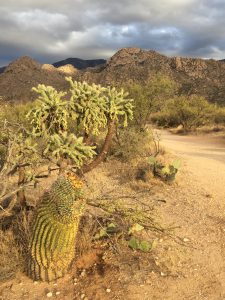
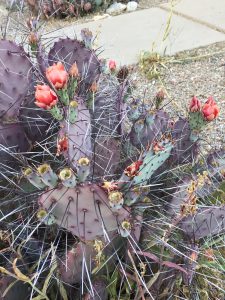

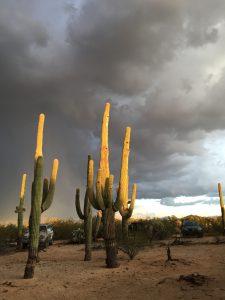



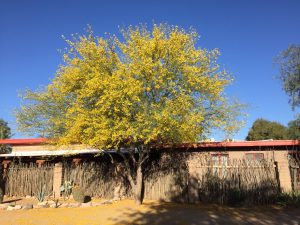

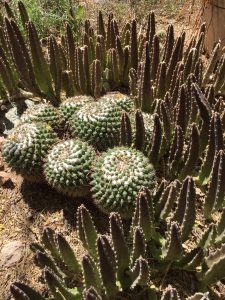
I have been living in New York for years now and whenever it reaches 90 something degrees, or not even, I would be complaining about how hot and humid it is. I cannot imagine how the hotness it is for those that live in Tuscon and any other deserted land. It’s crazy how people might have to flee because of the heat. I remembered a friend of mine who came from Arizona told me that they could literally fry an egg on the street. I was dumbfounded.
Sonya thank you for drawing attention to the climate challenges now looming over our very fragile Sonora desert region. Since moving here from the Midwest, I have come to appreciate the preciousness of water. After visiting briefly in Palestine very recently where some farmers subsist on fewer than 50 cubic liters of water per person per day, I am aware that even with the inevitable shortages we project, we don’t take seriously enough the need to conserve the resource in every way possible. I worked briefly at the Nassar family farm outside the city of Bethlehem and observed how they collected rainwater, efficiently washed dishes and pots with barely a gallon or two of water per meal, watered hundreds of plantings and small trees by hand. I was struck by all that we can learn in Tucson from people who have had to cope with water shortages for decades and even centuries.
Sonya thank you for drawing attention to the climate challenges now looming over our very fragile Sonora desert region. Since moving here from the Midwest, I have come to appreciate the preciousness of water. After visiting briefly in Palestine very recently where some farmers subsist on fewer than 50 cubic liters of water per person per day, I am aware that even with the inevitable shortages we project, we don’t take seriously enough the need to conserve the resource in every way possible. I worked briefly at the Nassar family farm outside the city of Bethlehem and observed how they collected rainwater, efficiently washed dishes and pots with barely a gallon or two of water per meal, watered hundreds of plantings and small trees by hand . One day this desert, which boasts, as Ms. Landau pointed out, an abundance of flora, cacti and fauna, will be confronted full force with the critical shortages already evident in many parts of the world due to changing climates.
Thanks to Sonya Landau for this wonderful expression of what we all feel when we come and become attached to this beautiful place that also fosters friendship and collective action to protect and honor this special place and its fantastic 4000 year old history. The descendents of those ancients are among us and we celeberate their gifts to the Tucson community. Tucson is also very special with the multitudes of activists who work to protect our landscapes, water resources, indigenous plants, cultural diversity and our place in our Mother Earth’s climate. Many many activists push and persuade for those growing numbers of solar panels, getting off fossil fuels, preserving and conserving water, enhancing neighborhoods, and most of all….. kindness and compassion for elsewhere besieged newcomers who risk their lives to join us.
Thank you for the insights regarding how current climate trends are effecting Tucson. I love the notion of solar panels that double as shade structures on playgrounds, sad to learn that the road runner of my childhood is not really 6′ tall and purple (hee hee), and in commiseration with the question of how long this ancient community can continue. Or at least continue in the current form, adding population with each year. The beautiful photos are a reminder to me of the delicate and subtle beauty of the desert.